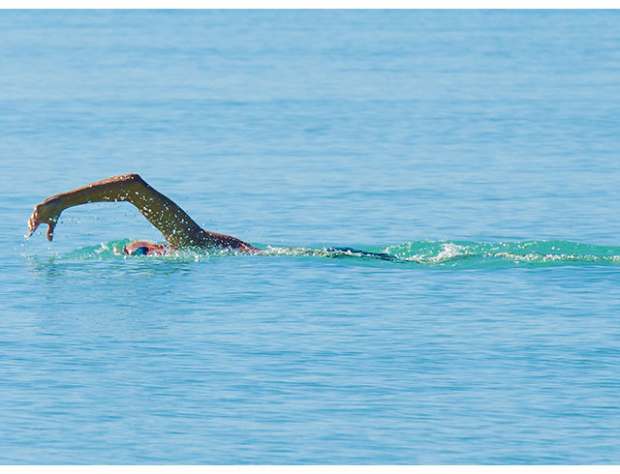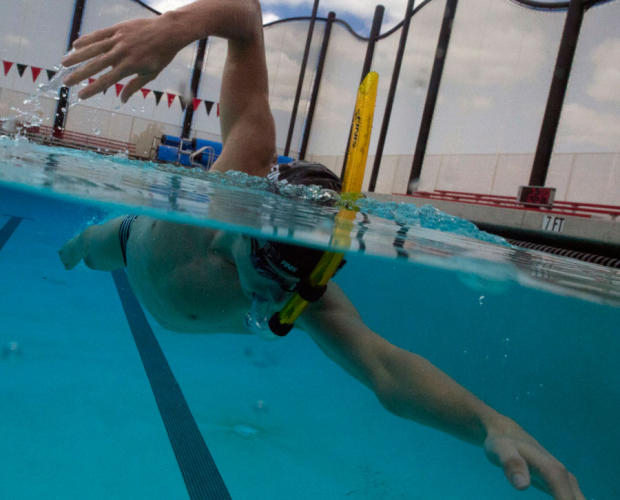Consecutive Breaths for Comfort and Confidence
I’ve never invented anything in the category of swim technique, and for good reason! I’m not even the fastest male 60-64 swimmer on my block, and there are only 2 houses on my block.
There’s a video below and maybe I’m too vain, or too self-critical, but I think lowly of my technique. But then I’m an adult onset swimmer. I’m a survivor. I’m writing on survival today, because of a thread on our reader forum about open water swimming.
I’m also a little bit lazy, by the way, so if you wonder why that video shows me swimming in a wetsuit in a pool on a 90 degree day in 80 degree water, it’s because I’m double dipping – pardon the pun – alongside a video I made of me swimming in a ROKA Maverick Pro II.

Here is the forum thread. It’s entitled FEAR of the SWIM, and is a post about a friend. “This is a guy who can finish off 2500 yds in a pool without stopping at a good clip with no problem.” But, in his race, “ he couldn't get enough air so had to stop.”
The thread’s replies range from folks who’ve had similar experiences – Ironman winner Greg Welch, a great swimmer, would occasionally have panic attacks in the swim – to those who felt that the wetsuit might be too tight. No telling. Could be a cardiac event. Impossible to diagnose with confidence.
That said, some of us are longitudinal experiments. I’ve noticed some things over my 40 years of triathlon. I raced this past weekend, the swim was about 1000 yards long, and I started to get a little out of breath, a little claustrophobic, after about 200 yards. But, I’ve been here many times before (I told myself). Sure enough, I was fine by 400 yards. Here are some of my impressions, with a specific technique tip a little further down.
Diaphragm Strength
For you young-uns, here’s often how it goes when you get older: You feel great swimming, you feel strong cycling, and you feel like a tiger on the run. But then when you look at the clock, you were more a cub, less a tiger. We just get slower. Weaker. My sense is that my diaphragm is much like the rest of my body’s muscles: It gets correspondingly weaker. This isn’t a big deal in the pool. But it is with the wetsuit on. When we’re younger our diaphragms overpower our wetsuits. Less so when we age. The last two races I was in, I felt pretty early – after 200 or so yards – that my wetsuit was tight. I adjusted to it in the water, during the swim. But, I didn’t use to feel that 20 years ago.
This means a couple of things. First, the older you get, err on the side of a roomier wetsuit. Not saggy. Just, not tight. Second, warm up well beforehand. Third if you can, best to get in some open water wetsuit swim beforehand, with some of it race simulated. It’s nice to know what to expect beforehand, so that whatever you encounter in the water you’ve encountered it before (and you know how to move past it or at least survive it).
Consecutive Breaths
This isn’t bilateral breathing. Or breathing every other stroke (the most typical technique). This is breathing even more often than that. The ability to execute consecutive breaths is a real age normalizer. Mind, the young guns are doing it now, taking consecutive breaths into the wall, especially in short course where you spend so much time underwater (where there is no air to breathe). The fitter I get, the less I need to resort to this. But this is a great skill for several reasons.
First, you get more air. Second, for me at least, this helps overcome that tight-wetsuit sensation a couple minutes into the swim. Third, if you miss a breath, which often happens in a triathlon, often at or near the start of a race, you can get that breath back immediately. Fourth, you get to see more – see what’s happening around you. Fifth, it evens out your stroke. Sixth, it makes you a better breather, technically.
This isn’t something you can immediately absorb. Taking consecutive breaths (breathe on the right, then immediately breathe on the left) is a learned skill; you can’t do it “in stride” right away. I was first turned onto this by Gary Hall, Sr., and he championed what he called 2:3 breathing. You take two consecutive breaths, then you move into standard right-side breathing for a cycle, then two more breaths, then left-side for a cycle.
I got pretty good at this. My stroke still sucked, but I could do this. It was liberating. Age defying. It was the fountain of youth for aging swimmers, or at least for this aging swimmer. But then I found that I could vary this. I could deploy it into a turn, out of a turn, whenever I wanted.
And now here’s where I go off the reservation. I could get even more air if I took 3 consecutive breaths. Why would I do this, instead of 2:3? It’s handy based on the open water conditions. I like to start off on the side of the wave, in a particularly competitive swim, because I don’t want to get beat up and swum over. I’d prefer to look away from the swimmers, that is, if I start on the left I want to breathe on the left, so that I don’t get molested when I’m breathing. But I still want to occasionally see to the right, to make sure I’m not drifting away from the pack, or to see if someone’s swimming by me whose feet might make a nice draft.
Or, there’s a swell hitting me on one side, so I want to breathe on the other. If I want to take consecutive breaths then I just take 3 and I’m back breathing on my favored side.
Okay, let’s be honest. There’s another reason. If I get lazy, and decide I just want to breathe on my natural side, but I want more oxygen, it’s 3 consecutive breaths and I’m not faced with breathing on my unnatural side.
In the video above (slowed to half speed) I attempt to demo both 2:3 breathing and 3-in-a-row. I haven’t named this technique because – come on! – I just can’t bring myself to actually name anything in swimming. I’m not good enough to have earned it. What I am is a 40-year veteran of triathlon, who has midpack talent (closer to the front now, because most oldsters don't swim very well). My one virtue is I am still in the pack, I’m still breathing, and not consigned to the couch.
I wish I could wave my wand and imbue everyone with at least the capacity to breathe consecutively. I think we older swimmers especially benefit from this. I like to think it would help keep us out of trouble. Fortunately, it is something we can learn and perfect in the pool.
I will say with some humor and chagrin that it seems the world of truly fast swimmers have caught up to what the oldsters (Gary Hall, Sr., in particular) first championed. Still, I’m fain to ask you to take technique instruction from me. I’m not that guy. I consider this more in the line of survival instruction. I’m happy to defer to those swimmers who are more adept, experienced, who are faster, who are way beyond me. This is simply a skill and a technique that has stood me in good stead; kept me a confident open water swimmer as I have aged; and gifted me with more capacity for speed than I’m probably due. I like to think this skill is worth 5 or 10 percent more oxygen consumption, is cheaper than anti-aging techniques, and easier on the conscience.



